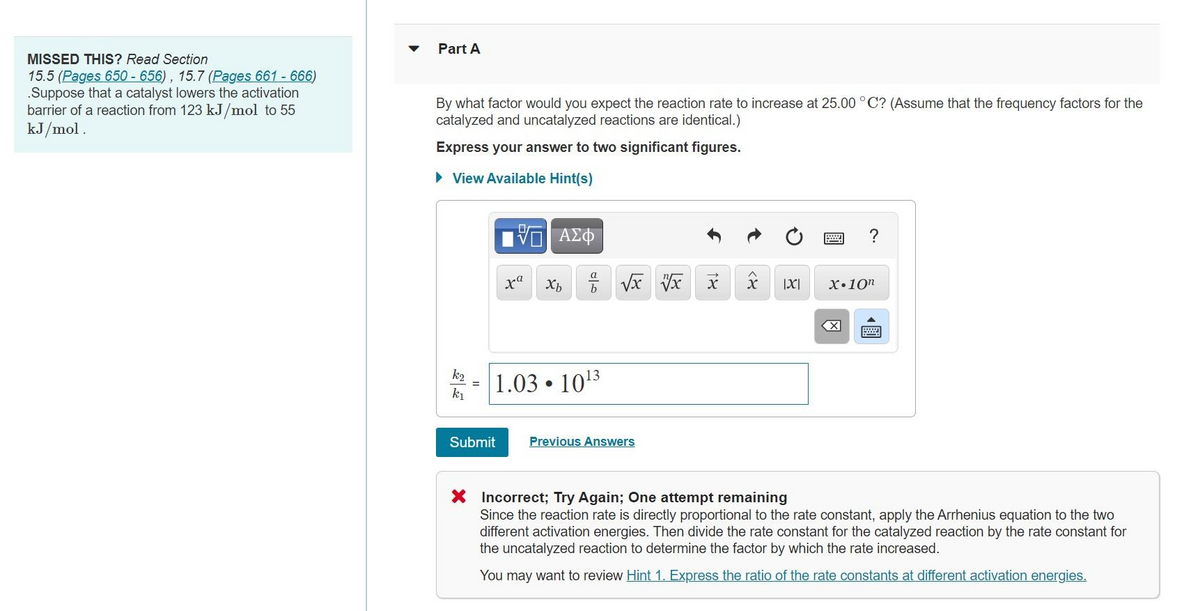Part A MISSED THIS? Read Section 15.5 (Pages 650 - 656), 15.7 (Pages 661 - 666) .Suppose that a catalyst lowers the activation barrier of a reaction from 123 kJ/mol to 55 kJ/mol. By what factor would you expect the reaction rate to increase at 25.00 °C? (Assume that the frequency factors for the catalyzed and uncatalyzed reactions are identical.) Express your answer to two significant figures. > View Available Hint(s) Πνα ΑΣΦ Xb Vx Vx |X| x•10" =|1.03 • k1 1013 Submit Previous Answers X Incorrect; Try Again; One attempt remaining Since the reaction rate is directly proportional to the rate constant, apply the Arrhenius equation to the two different activation energies. Then divide the rate constant for the catalyzed reaction by the rate constant for the uncatalyzed reaction to determine the factor by which the rate increased. You may want to review Hint 1. Express the ratio of the rate constants at different activation energies.
Part A MISSED THIS? Read Section 15.5 (Pages 650 - 656), 15.7 (Pages 661 - 666) .Suppose that a catalyst lowers the activation barrier of a reaction from 123 kJ/mol to 55 kJ/mol. By what factor would you expect the reaction rate to increase at 25.00 °C? (Assume that the frequency factors for the catalyzed and uncatalyzed reactions are identical.) Express your answer to two significant figures. > View Available Hint(s) Πνα ΑΣΦ Xb Vx Vx |X| x•10" =|1.03 • k1 1013 Submit Previous Answers X Incorrect; Try Again; One attempt remaining Since the reaction rate is directly proportional to the rate constant, apply the Arrhenius equation to the two different activation energies. Then divide the rate constant for the catalyzed reaction by the rate constant for the uncatalyzed reaction to determine the factor by which the rate increased. You may want to review Hint 1. Express the ratio of the rate constants at different activation energies.
Chemistry: The Molecular Science
5th Edition
ISBN:9781285199047
Author:John W. Moore, Conrad L. Stanitski
Publisher:John W. Moore, Conrad L. Stanitski
Chapter11: Chemical Kinetics: Rates Of Reactions
Section: Chapter Questions
Problem 11.ACP: (Section 11-5) A rule of thumb is that for a typical reaction, if concentrations are unchanged, a...
Related questions
Question

Transcribed Image Text:Part A
MISSED THIS? Read Section
15.5 (Pages 650 - 656), 15.7 (Pages 661 - 666)
.Suppose that a catalyst lowers the activation
barrier of a reaction from 123 kJ/mol to 55
kJ/mol.
By what factor would you expect the reaction rate to increase at 25.00 ° C? (Assume that the frequency factors for the
catalyzed and uncatalyzed reactions are identical.)
Express your answer to two significant figures.
> View Available Hint(s)
?
|X|
X•10n
k2
1.03 • 1013
k1
Submit
Previous Answers
X Incorrect; Try Again; One attempt remaining
Since the reaction rate is directly proportional to the rate constant, apply the Arrhenius equation to the two
different activation energies. Then divide the rate constant for the catalyzed reaction by the rate constant for
the uncatalyzed reaction to determine the factor by which the rate increased.
You may want to review Hint 1. Express the ratio of the rate constants at different activation energies.
國
國
Expert Solution
This question has been solved!
Explore an expertly crafted, step-by-step solution for a thorough understanding of key concepts.
This is a popular solution!
Trending now
This is a popular solution!
Step by step
Solved in 2 steps with 2 images

Knowledge Booster
Learn more about
Need a deep-dive on the concept behind this application? Look no further. Learn more about this topic, chemistry and related others by exploring similar questions and additional content below.Recommended textbooks for you

Chemistry: The Molecular Science
Chemistry
ISBN:
9781285199047
Author:
John W. Moore, Conrad L. Stanitski
Publisher:
Cengage Learning

Chemistry
Chemistry
ISBN:
9781305957404
Author:
Steven S. Zumdahl, Susan A. Zumdahl, Donald J. DeCoste
Publisher:
Cengage Learning


Chemistry: The Molecular Science
Chemistry
ISBN:
9781285199047
Author:
John W. Moore, Conrad L. Stanitski
Publisher:
Cengage Learning

Chemistry
Chemistry
ISBN:
9781305957404
Author:
Steven S. Zumdahl, Susan A. Zumdahl, Donald J. DeCoste
Publisher:
Cengage Learning


Chemistry: An Atoms First Approach
Chemistry
ISBN:
9781305079243
Author:
Steven S. Zumdahl, Susan A. Zumdahl
Publisher:
Cengage Learning

Principles of Modern Chemistry
Chemistry
ISBN:
9781305079113
Author:
David W. Oxtoby, H. Pat Gillis, Laurie J. Butler
Publisher:
Cengage Learning

Chemistry for Engineering Students
Chemistry
ISBN:
9781337398909
Author:
Lawrence S. Brown, Tom Holme
Publisher:
Cengage Learning